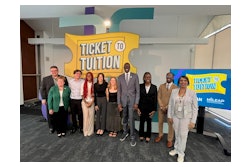Truth In Advertising
University advertising campaigns struggle to speak to minorities without being misleading.
By Eric Butterman
Picture this: A group of ethnically diverse students studying together in expansive, state-of-the-art libraries or strolling across perfectly manicured campus lawns engaged in intelligent conversation — congregating as one in all higher education has to offer. This is an image colleges and universities often portray in recruitment brochures, and sometimes it’s even true. But when it’s not, these marketing materials can be embarrassing or worse.
Drake University has been criticized for running ads depicting more diversity than there really was. As a result, president David Maxwell now personally approves each ad.
“I look through every ad we use and have to ask myself if it’s accurately reflecting Drake,” Maxwell says. “We did something where we featured an African-American student, and I had to think hard about whether it was overstating things. But to not feature this student would have been wrong. She was involved in crew and many activities. She’s such a part of this place — truly a part of the face of Drake.”
Hector Orci, co-chairman of La Agencia De Orci, an advertising agency in
Los Angeles, agrees that there’s some balancing involved.
“Colleges just can’t put minorities all over their ad campaigns and think they’ll get away with misrepresentation,” says Orci. “At the same time, they must have some diversity in their ads or minorities will feel they’re not wanted. A welcoming campaign showing minority faces isn’t misleading — it opens doors.”
For example, says Orci, if a college is trying to attract a diverse student body, then it must speak to the specific minority group’s needs.
“Latinos are family-oriented, it’s difficult for them to be away from home,” he says. “I need to know through pictures or words how you will take care of my needs. Get specific.”
Orci also points out that as consumers, Blacks are generally very skeptical.
“They have a good nose for lies because they get them all the time. Be clear about what you’re offering or they’ll see it for the weak attempt that it is,” he says.
Joel Mahan, a New York-based commercial actor and an alumnus of Seton Hall University, says his alma mater tried to represent itself in advertising campaigns as being far more diverse than the “largely White Catholic university” it actually was.
“I saw some advertising from Seton Hall mixing in many diverse images,” says Mahan, who is Black. “But the majority of the actual activities and events were overwhelmingly White, except for sports.”
Mahan recommends that colleges and universities “run ads in largely minority-read publications. Or, if you’re advertising on Black Entertainment Television, for example, the audience will get the message that you’re interested in African-Americans. Another strong opportunity is during televised college sporting events where you can announce an interest in diversity.”
Mahan says he has no problem with featuring minorities in college ads, as long as their representation comes within 5 percent to 10 percent of the actual makeup of that minority group on campus.
“I heard about a college that got in trouble for photoshopping an African-American into an ad,” Mahan says. “Though this is an extreme situation, it shows how desperate colleges can be.”
The University of Wisconsin-Madison was that school, digitally inserting a Black student into a photo of White football fans in 2000 in an attempt to show diversity. Instead, it brought national criticism and embarrassment. The incident cost the university more than $60,000 to recall all the materials.
It may be tempting, says Orci, but “the one time you get caught lying to students will bring about major damage — and sometimes it can’t be fixed.”
© Copyright 2005 by DiverseEducation.com


















